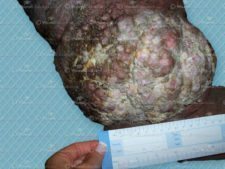Lymphedema Risk Factors and Diagnosis
Lymphedema is a debilitating condition in which lymphatic fluid accumulates in the interstitium causing swelling and a feeling of heaviness or weakness in the affected area, usually the arms and legs.1
Lymphedema Risk Factors

A number of factors are known to increase the risk of developing lymphedema, with cancer treatment being a major risk. Lymph-node dissection during mastectomy for breast cancer is a common cause of subsequent lymphedema, as well as radiation therapy for a range of cancers.2,3 As the risk for lymphedema is lifelong, the onset may occur at the time of the initiation of treatment or be delayed, even for several decades.4 Other risk factors for lymphedema include major trauma or burns, a family history of lymphedema, and high body mass index.5 Exposure to filarial infection, which is a mosquito-borne illness common in Asia and Africa, also increases the chance of developing the condition.6
Lymphedema Signs and Symptoms
It is important to be able to recognize the early signs and symptoms of lymphedema before a formal clinical diagnosis is made, in order to recognize the condition early and offer better management. In particular, healthcare professionals should observe the limbs of post-mastectomy patients and other patients who have received cancer treatment and note any reported heaviness or tightness, aching or discomfort, restricted range of motion, or swelling in a portion of the limb or the entire limb.7
Lymphedema Diagnosis
A formal clinical diagnosis of lymphedema begins with a thorough medical and surgical history.7 Observation of the limb should be performed to include skin mobility, tissue consistency, and the presence or absence of fibrosis noted, as well as whether the edema is pitting or nonpitting. Pain level should be recorded as well as the presence of the Stemmer sign. Digital photography and measurements of girth and volume should also be performed.7
Additional diagnostic testing such as lymphoscintigraphy, used to detect blockages in the lymph vessels or the absence of lymph vessel, may also be necessary. Other tests may be performed to exclude the other causes of leg swelling, such as a CAT scan or MRI, blood tests, or an ultrasound to exclude the presence of a blood clot.7
The implications of overlooking lymphedema, or diagnosing the condition late, can be devastating, potentially leading to patient discomfort, pain, and immobility. Greater knowledge and understanding of the risk factors and diagnosis of this debilitating condition can be gained by undertaking additional professional training, including studying for a certification in wound management.
Learn More With Our Wound Care Education Options
Interested in learning more about wound care and certification? Browse through our online wound care certification courses for information on our comprehensive range of education options to suit healthcare professionals across the full spectrum of qualifications and experience.
References
- Myers BA. Wound management principles and practice. 2nd ed. Upper Saddle River, NJ: Pearson; 2008.
- Meeske KA, Sullivan-Halley J, Smith AW. Risk factors for arm lymphedema following breast cancer diagnosis in Black women and White women. Breast Cancer Res Treat. 2009;113(2):383-91.
- Norman SA, Localio AR, Kallan MJ. Risk Factors for Lymphedema after Breast Cancer Treatment. Cancer Epidemiol Biomarkers Prev; 19(11); 2734–46.
- Brennan MJ, Weitz J. Lymphedema 30 years after radical mastectomy. Am J Phys Med Rehabil. 1992; 71: 12–14.
- Ridner SH, Dietrich MS, Stewart BR. Body mass index and breast cancer treatment-related lymphedema. Support Care Cancer. 2011 Jun;19(6):853-7.
- Lymphatic filariasis. Prescrire Int. 2008;17(93):36.
- Lawenda BD, Mondry TE, Johnstone PA. Lymphedema: a primer on the identification and management of a chronic condition in oncologic treatment. CA Cancer J Clin. 2009;59(1):8-24.

Barbara,
Thank you for sharing a very sad possibly preventable outcome with your loved one. This si why we as Nurses need to stand up for are patients who are note recieving adequate pain management. With all the pharmaceutical treatment modalities available to us in this day and age…Healthcare providers should be utilizing these medications(even concious sedation when needed) to minimize psychological effects that pain,depression and anxiety can cause…clearly his quality of life was poor as a result of the pain. Very Very sad. We need to do better!